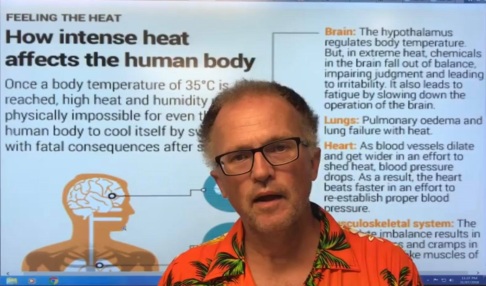Above image shows temperatures north of 80°N. The red line on the image shows the 2019 daily mean temperature up to Oct 13, 2019. The temperature is now well above the 1958-2002 mean (green line). The image also shows the freezing point of fresh water (273.15K, 0°C or 32°F, blue line).
The freezing point for salt water is lower, at around -2°C, or 28.4°F, or 271.2°K. In other words, a rise in the salt content of the water alone can make ice melt, i.e. even when the temperature of the water doesn't rise.
Above combination image shows forecasts for October 26, 2019. The left panel shows that air temperatures (2 m) are forecast to be 5.4°C higher over the Arctic than 1979-2000. Parts of the Arctic Ocean where there is no sea ice are forecast to be especially hot, since this is where heat gets transferred from the Arctic Ocean to the atmosphere. Anomalies are as high as 30°C, the top end of the scale. Temperature anomalies are in line with changes to the Jet Stream, as illustrated by the forecast in the right panel.
As above image shows, there was very little sea ice north of Greenland on October 11, 2019. Arctic sea ice extent is very low. As the image below shows, Arctic sea ice extent was 4.88 million km² on October 13, 2019, the lowest on record for the time of year.
 |
| [ click on image to enlarge ] |
As the image below shows, the heat rising from the Arctic Ocean is such that sea ice extent is hardly growing.
The image below shows Arctic sea ice extent for the years, 1980,1990, 2010, 2012 and 2019, for the period as indicated.
The image below indicates that Arctic sea ice volume has been at record low levels for the time of year for some time.
The image indicates that a critical tipping point was crossed this year, with the disappearance of the thick sea ice that hangs underneath the surface.
This indicates that the buffer has gone that has until now been consuming ocean heat as part of the melting process. As long as there is sea ice in the water, this sea ice will keep absorbing heat as it melts, so the temperature will not rise at the sea surface. The amount of energy absorbed by melting ice is as much as it takes to heat an equivalent mass of water from zero to 80°C.
 |
| [ click on image to enlarge ] |
How hot is that water flowing into the Arctic Ocean? The image on the right shows sea surface temperature anomalies. On October 13, 2019, the sea surface near Svalbard at the green circle was 18.3°C or 65°F, i.e. 14.7°C or 26.4°F hotter than 1981-2011.
This is an indication of how hot the water is underneath the sea surface. At the sea surface, water gets colder due to evaporation and rain, resulting in a lid of fresh water at the surface sealing off hot and salty water underneath.
This hot and salty water moves underneath the sea surface in line with the deeper parts of the ocean, to emerge at this area near Svalbard (marker in the image below), as the water at this area becomes more shallow, making the sea current push the water to the surface.
Back in 2011, a study by Micha Ruhl et al. pointed at huge methane releases from clathrates during the end-Triassic mass extinction event, as discussed in an earlier post. The danger is that, in the absence of thick sea ice, hot water with a high salt content will reach the seafloor of the Arctic Ocean, making it easier for ice in cracks in sediments at the seafloor to melt, resulting in huge methane releases.
 |
| [ from an earlier post ] |
The situation is dire and calls for comprehensive and effective action, as described in the Climate Plan.
Links
• Climate Plan
https://arctic-news.blogspot.com/p/climateplan.html
• Critical Tipping Point Crossed In July 2019
https://arctic-news.blogspot.com/2019/09/critical-tipping-point-crossed-in-july-2019.html
• Most Important Message Ever
https://arctic-news.blogspot.com/2019/07/most-important-message-ever.html
• Arctic Ocean overheating
https://arctic-news.blogspot.com/2019/09/arctic-ocean-overheating.html
• How extreme will it get?
https://arctic-news.blogspot.com/2012/07/how-extreme-will-it-get.html
• Warning Signs
https://arctic-news.blogspot.com/2018/03/warning-signs.html













































